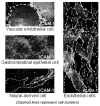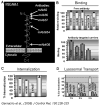Challenges in design and characterization of ligand-targeted drug delivery systems
- PMID: 22709588
- PMCID: PMC3481020
- DOI: 10.1016/j.jconrel.2012.05.052
Challenges in design and characterization of ligand-targeted drug delivery systems
Abstract
Targeting of therapeutic agents to molecular markers expressed on the surface of cells requiring clinical intervention holds promise to improve specificity of delivery, enhancing therapeutic effects while decreasing potential damage to healthy tissues. Drug targeting to cellular receptors involved in endocytic transport facilitates intracellular delivery, a requirement for a number of therapeutic goals. However, after several decades of experimental design, there is still considerable controversy on the practical outcome of drug targeting strategies. The plethora of factors contributing to the relative efficacy of targeting makes the success of these approaches hardly predictable. Lack of fully specific targets, along with selection of targets with spatial and temporal expression well aligned to interventional requirements, pose difficulties to this process. Selection of adequate sub-molecular target epitopes determines accessibility for anchoring of drug conjugates and bulkier drug carriers, as well as proper signaling for uptake within the cell. Targeting design must adapt to physiological variables of blood flow, disease status, and tissue architecture by accommodating physicochemical parameters such as carrier composition, functionalization, geometry, and avidity. In many cases, opposite features need to meet a balance, e.g., sustained circulation versus efficient targeting, penetration through tissues versus uptake within cells, internalization within endocytic compartment to avoid efflux pumps versus accessibility to molecular targets within the cytosol, etc. Detailed characterization of these complex physiological factors and design parameters, along with a deep understanding of the mechanisms governing the interaction of targeted drugs and carriers with the biological environment, are necessary steps toward achieving efficient drug targeting systems.
Copyright © 2012 Elsevier B.V. All rights reserved.
Figures









References
-
- Dingemanse J, Appel-Dingemanse S. Integrated pharmacokinetics and pharmacodynamics in drug development. Clin Pharmacokinet. 2007;46(9):713–737. - PubMed
-
- Takimoto CH. Basic pharmacokinetics and pharmacodynamic principles. Cancer Treat Res. 2001;106:85–101. - PubMed
-
- Torchilin VP. Drug targeting. Eur J Pharm Sci. 2000;11(Suppl 2):S81–91. - PubMed
-
- Kohler G, Milstein C. Continuous cultures of fused cells secreting antibody of predefined specificity. Nature. 1975;256(5517):495–497. - PubMed
-
- Hoffman AS. The origins and evolution of “controlled” drug delivery systems. J Control Release. 2008;132(3):153–163. - PubMed
Publication types
MeSH terms
Substances
Grants and funding
LinkOut - more resources
Full Text Sources
Other Literature Sources

